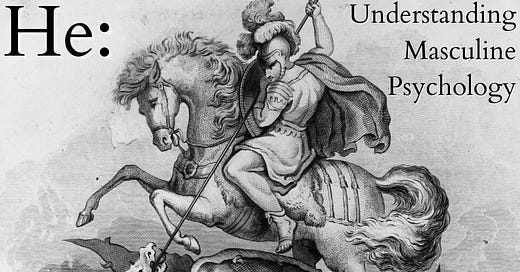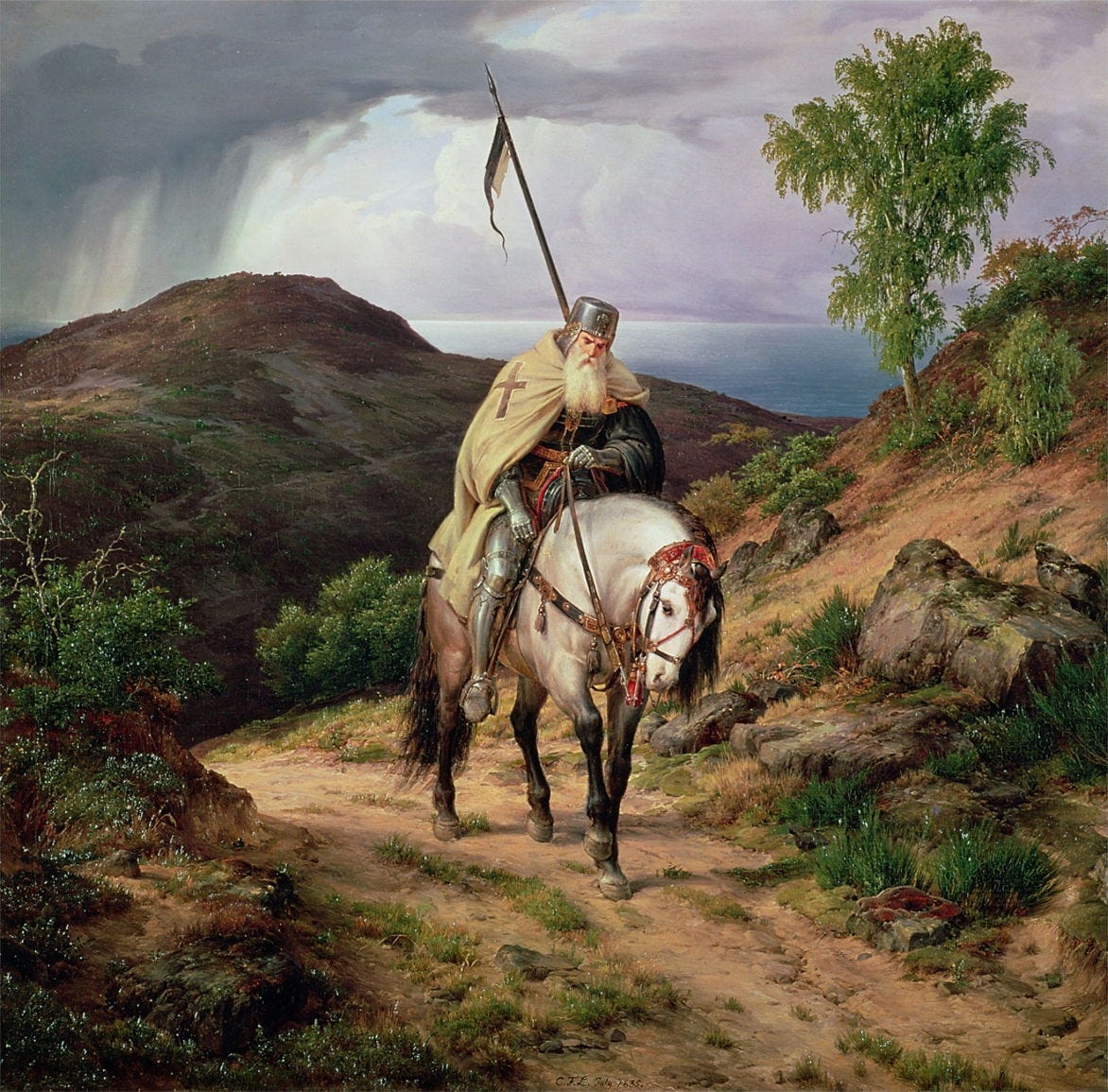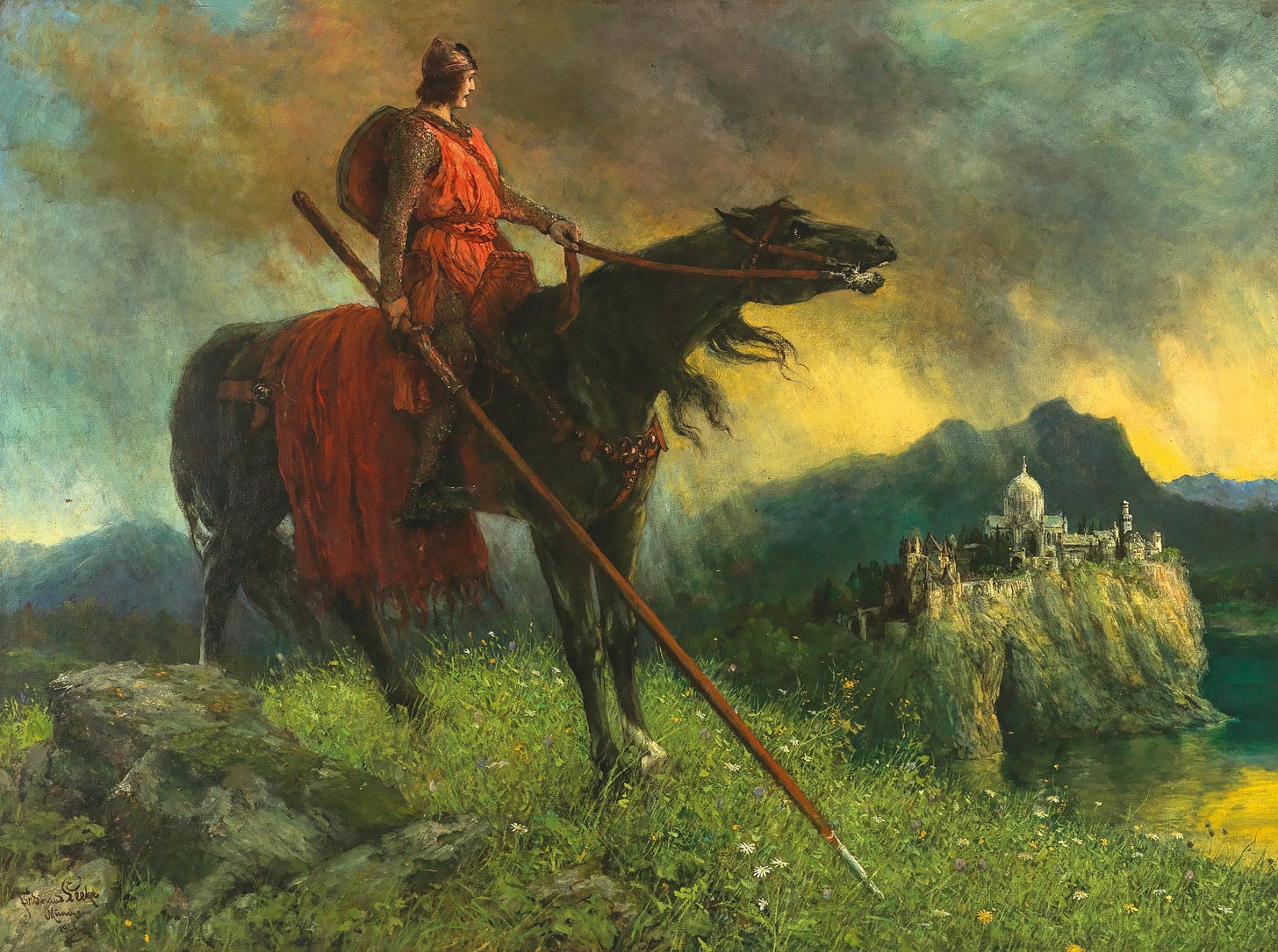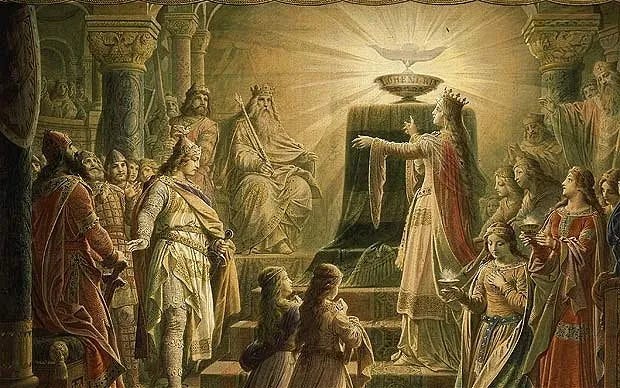He: Understanding Masculine Psychology by Robert A. Johnson
Understand the path to courage, adventure and fulfilment by studying legend
Hello friends, hope you’re still going to the gym like you told yourself you would. All slightly personal jokes aside, today we have a masterpiece in wisdom that only the great late Robert A. Johnson (the famed Jungian analysis) could manage to place into such a page-turning narration.
This study will give you the quintessence of the book, and help you on your way to conquering modern age dragons (i.e. sticking to a gym routine). This book and it’s ideas are not only for men, though obviously masculinity is more prevalent in males (for the most part) – females have just as much a need of masculine traits such as: courage, commitment and perseverance. And before you sentence me to death for sexism, let me balance that statement by saying that men have also such a need of feminine traits like: creativity, kindness and appreciation of beauty (we’ll leave childbirth to you though).
Whatever stage you are in in life, or whoever you are, I am sure you will find the ideas found in this book as useful as I did – or at least interesting.
See below for:
About the Author
An overview
Key-points
By being at the cutting edge of AI technology, The Weekly Book Study is now available in audio format 🤖
Speak, Memory by Danny Norbury
📚 He: Understanding Masculine Psychology by Robert A. Johnson
About the author
Robert A. Johnson was an eminent Jungian analysis (psychotherapist). Known for his soft and subtle demeanour, Robert was well loved by his colleagues. Born 1921, in Portland, Oregon, Robert followed an academic path; studying at the University of Oregon and also Stanford. He also followed another doctrine, at a young age he became a disciple of the famous spiritual teacher Jiddu Krishnamurti, who’s instructions evolved around the rejection of organised religion and an attainment of self-realisation by introspective meditation. His interest in Eastern philosophy would later lead him to become a member of the Sri Aurobino Ashram in Pondicherry, India.
He began his ambitions of becoming a Jungian psychologist at the C.G Jung Institute in Zurich, Switzerland. His principal analyse (the person who analysed his dreams etc) was non-other than Emma Jung – the wife of Carl Jung.
After completing his training he moved to California, where he opened a practice in the early 50s. In 1963 he closed the practice, to become a member of the St. Gregory's Abbey, Three Rivers, in Michigan, a Benedictine monastery of the Episcopal Church – If you’ve not already caught on this man is the archetypal introvert.
He returned to his practice in 67. 7 years later a collection of his lectures was published as ‘HE: Understanding Masculine Psychology’, becoming an instant bestseller. Along with 13 other titles, he published ‘She: Understanding Feminine Psychology (1976); ‘We: Understanding the Psychology of Romantic Love’ (1983) and ‘Inner Work: Using Dreams and Active Imagination for Personal Growth’ (1986). In all, his works have sold over 3-million copies world wide. Another noticeable achievement is being given an honorary doctorate by the Pacifica Graduate Institute in California.
Johnson lived to the impressive age of 97, he died in 2018, in San Diego, California.
📝 Overview
This is a nicely paced and easy read coming at 100 pages. Though referring to Jungian concepts such as the shadow, archetypes and individuation, ideas that those new to this school of thought might find confusing (luckily you have me to help); Robert however, being a brilliant narrator, structures this information superbly, explaining everything relevant along the way when necessary.
The premise of the book follows the original story of Parsifal (later adapted to percival) the Arthurian knight of legend, and his quest for the Holy Grail. There are various versions of this myth (Monty Python’s being my personal favourite), but this is the original composed by the Frenchman Chrétien de Troyes in 1180. A classic hero story, the details of which we will talk through now.
✏️ Key points
The Heroes Journey
For those familiar with Joseph Campbells ‘The Hero with a Thousand Faces’, will instantly find themselves at home with this book. But it important to note that, while Campbell’s work is focused more on the recurring pattern of these stories, this work is concentrated on interpreting and pulling as much value out of these stories as possible. I personally found Campbell’s book a convoluted mess–but thats for another time. It is refreshing to read such a book as this, while it knows of the similarities of all hero myths, it concentrates on this one (with a few references to others once or twice). Campbell’s book was inspired by–and largely based on–the works of Carl Jung; so read on assured that the context of this book is as close to the source material as it can be: seeing that Johnson was an acquaintance of Jung himself.
We will conduct our study of this book in the same way the author does: by telling the story of Parcifal and his search for the Grail, and picking up on stages of masculine development and archetypal figures as we go.
Origins of the Hero
Parsifal is not born with superpowers like much of our modern heroes are, he is not born anywhere impressive, and from the first glance he seems to be in no circumstances to be anyone of important or future fame. This is very important. You see he his actually born to a single mother, who lives in a wood, alone, in Wales. The significance of this is that he is an unassuming hero, from the fringes of the phenomenal world (Sorry Wales, but after living in Glamorgan for 6 years I can attest to this). This is accentuated by the fact that Parsifal’s name actually means something similar to ‘young-fool’.
One day while walking in the woods he spots five knights of King Arthur’s court, gleaming in their astounding splendour and valour riding through the woods. Parsifal thinks he has seen angels, and running home to his mother (who’s name is Heart’s Sorrow, more on that later), he exclaims what he has seen.
Bursting into tears, his mother explains to him that they were knights, and how his own father, along with his brothers were also knights. The reason we haven’t seen them yet is because they all died chivalric deaths. The reason they live so deep in the woods is because Heart’s sorrow wishes to protect Parcifal from following the same path and meeting the same fate.
Call to adventure
The call to adventure for Parcifal is learning of his lineage. From his encounter with the five knights a burning desire overcomes the hero, and he resolves to leave his quiet life and quest to King Arthur’s court. One thing to note before we move on is the significance of the number five. This number in archaic myths often indicates wholeness; in the context of this story, Parcifal seeing five knights that amaze him so much indicates that seeking knighthood is his path towards wholeness.
With Parcifal set to leave, his mother eventually relents, and gives him a peasants garment for him to wear on his journey, and also some advice: ‘do not ask questions in the presence of superiors’. Seemingly sweet things, but ultimately detrimental to his success, as we will soon see.
The takeaways for masculinity here is that of escaping the mother. Something that society seems to neglect in its full. Mothers are incredible, they give and nourish life, but like all things they hold a dark side, and any man who has had to pull themselves away from their mother will vouch for this. The difference between the benevolent and tyrannical mother, is the former will have the courage to let their children go into the big scary world when the time to become a man arrives; while the latter will cling to their motherhood, and smother the child in order to keep them in a juvenile state of need, so that they can fulfil their nurturing instincts. This is a lot to unpack, and we will save the angle of the mother for another day; but the key point is that the boy – in order to become a man – must free himself of the mother in order develop into a capable male.
Followers of my Instagram page will have seen a clip I posted of Robert A. Johnson talking about the psychology of dragons in western culture; Robert states that “the dragon almost always represents a man’s mother complex”. A mother complex, he goes on to relate, is a man’s desire to be nurtured. This is the same force that makes you want to pull your warm safe blankets over your head in the morning – avoiding what the day holds for you. This, as you can imagine, is going to stop any to-be hero from getting out the door and kill that damn dragon that has been pestering everyone.
This complex is represented by that garment Parsifal is given by his mother, and many of the dragons he fights later on in the myth are representative of him fighting his mother complex.
King Arthurs court and the Red Knight
Parsifal travels to the court of legend to request knighthood, and is met by sneers and ignominy – and some good advice. He is told that to become a knight requires many years of training to understand the many martial fields of knowledge: sieging, swordsmanship, rescuing fair maidens etc etc.
But something strange happens. A maiden of court, who has not laughed or smiled for a period of years–who has been prophesied that her spell of gloom shall be broken by the greatest knight there will ever be. And guess what happens when she sees the young fool wearing a peasant garment his mother made for him? She laughs.
This is a testament to the holiness of the Fool. A thought our culture teaches us to rive and squirm at, a reaction that stops many from even thinking about starting a new venture. Even the greatest of professionals once understood their craft as little as we know now – you should find this reassuring. We have to be the Fool if we ever hope to achieve anything, it is an unavoidable step; therefore the fool is holy.
King Arthur heeds the prophesy and knights Parsifal there and then. One problem remains however, despite in theory being a knight, our protagonist does not have armour, a horse or even a sword – you know, knight stuff. On request of these items Parsifal is told to go get them. Parsifal’s answer to this is if he can defeat the Red Knight, could he keep his equipment? The court burst into uproar once more, “sure", the King replies Probably wiping a tear from under his eye, “if you can beat him”.
The Red Knight is sheer terror, a man so strong and imposing that all in the court of Arthur are unable to prevent him from doing whatever he wants: stealing silverware, also a chalice, and to top it all off, throwing a flagon of wine into the queen of the court’s (Quenevere herself) face. The hero confronts the towering figure, and asks him for his armour, to which the red menace replies something to the tune of “Molon labe”.
The two clash, after a short fight Parsifal is knocked to the ground – and in a move that echoes David and Goliath – throws his dagger into the face of the Red Knight.
In the moment that Parsifal kills his better – and seemingly far so – opponent, the boy becomes a man. This insurmountable challenge is one we all must face in order to enter into masculinity, though this will take many forms (non of which killing a man in red armour… I hope), such an event represents passing ones initiation, gaining the right to be taken seriously.
Mentor
After this feat, Parsifal returns to the court: where he is taken a tad more seriously than he was before. He is given a teacher – Gournamond. He is taught all knightly things, and told one very specific piece of advice: if he finds himself inside the Grail Castle (something we will touch on shortly) he should ask the question “whom does the Grail serve?” (again we will explain this at the appropriate time).
The idea of the mentor is a very important one for young men. There comes a time when the relationship to the father reaches a natural end, and learning anything more about life becomes difficult – and sometimes detrimental. This is the opportune time for a Godfather figure to step in and provide further teachings of the world that a father that has nurtured a child through boyhood cannot. For many, this is an uncle who introduces a boy to some of the wilder things, not being tied to the mother, this figure is free to expose a pupil to some harsher truths in life.
The first encounter with the Grail Castle
Parsifal reaches the end of his training, and as he is fitting his armour before heading out into the big bad world; but as he is doing this it is apparent that he hasn’t taken his mothers garment off from earlier, and is trying to fit it on under the armour. His squire notices this, and suggests that it is not such a knightly thing to ride about in peasant's clothes. But Parsifal persists and fits it on under: a mixture of mother-complex under a layer of chivalry can be dangerous.
Parsifal gets into lots of adventures, but it is not long until he finds himself in the profoundest of places.
He comes across an old man on a boat one day, and after exchanging pleasantries, the man offers the young knight a place at his home tonight. Instructing him to head along the road, and left across the bridge.
Following these instructions he finds the place and enters, it turns out to be a castle. As he crosses the drawbridge, the thing snaps shut – a few paces back and he and his horse would have been killed, but luckily only the rear of the horse's shoes were scuffed.
Parsifal has entered the Grail Castle, the place of the inner court; an analogy for the sacred place inside all of us. This being only ‘along the road and left over the bridge’ indicates how close this place is. And the almost catastrophe on the drawbridge, the danger of entering into this realm – the inner world.
The Fisher King
The lord of this castle is a wounded man. His injury came to him one day when out exploring; he came across a deserted camp by a river, and found a cooked salmon over a fire. He picked the fish up to take a bite and burnt his hand, dropping the morsel on the floor he placed his burnt finger into his mouth: this is how the King learnt of good and evil, and gained his wound.
This is close to the story of the garden of Eden, except it is a fish (a symbol of Christ) and not an apple that opens the way to consciousness. Most think of their earliest memories with fondness, a time of undivided joy; it was when we learnt more of the world and its strange ways that we lost that childhood innocence (i.e. when we came into consciousness).
This is the first stage of life: unconscious happiness. The second, where the Fisher King is now–and most of us are–is conscious unhappiness. It is the task of life the Jungians believe, to develop into the third stage: conscious happiness. To do this we need to reconcile the split that was made when we first ate of the apple, tasted the fish and came into the phenomenal world – when paradise was lost.
The wound the Fisher King has is one to his thigh, this indicates that his virility as a man has been damaged; and in classic fairy-tale fashion, when the King is unwell, so is the kingdom. Other versions of the myth are not so subtle, one of them stating that the injury the King suffers is an arrow that goes through both testicles – speaks for itself right?
The King can only find relief while in a fishing-boat, maybe a hint at how men negate pain by plunging our heads into our hobbies; this is where he gets his name. This is the man in the boat we met earlier.
Failure in the castle
We find Parsifal the guest of honour in this court, why? Because it has been said that only a fool can heal the King – and what does this young knight squeezed into armour look like? – But only if he asks the right question – remember what the mentor told Parsifal to do earlier if he found himself in the Grail castle?
A ceremony ensues, one that happens every night. Three maidens walk out in procession holding some very holy items: the spear of Longinus (the one that speared Jesus on the cross), a platter from the last supper, a cornucopia, and the main event, the Holy Grail. The Grail gives all those in attendance many beautiful things, good health and food etc; cruelly however, the one person who cannot touch it is the Fisher King.
The Grail in this scenario is the waters–or source–of life. And the King is our damaged selves, in dire need of it, but seemingly the only one who cannot touch it. A feeling a few of you will be able to relate. The short of it, is it takes the Fool to heal this part of ourselves.
Now, Parsifal sits there, realises he’s in the Grail Castle, and remembers what he was told to ask by his mentor: “Whom does the Grail serve?”. With the question on the tip of his tongue – he pauses – and remembers what his mother told him before he left: “do not ask questions in the presence of superiors”. Feeling for a reassuring touch of his under garment, he resolves to keep his good mothers advice.
The night ends, all disperse, he is shown to his quarters; when he awakes he finds the castle deserted – not a soul. He sees himself out, the drawbridge clipping his horse’s hooves like before as he enters into confusion he wonders upon an old lady close by; after relating his experience to her, she exclaims “that was the Grail Castle you idiot, why didn’t you ask the question?”. Dumfounded by his mistake, and realising he could have healed the King – therefore the Kingdom – and wonders on his way.
The Dark Night of the Soul across the Wasteland
A dramatic heading (thank you I amalgamated it myself), It holds the essence of what this stage looks like. After his mistake in the Grail Castle, Parsifal travels around the land for many – many years, where he fights dragons, sieges-castles et cetera et cetera. This is what medieval mystics called the dark night of the soul, a period after ones initial taste of the divine–or spiritual awakening as it is more commonly known as today–which gives us a flavour the profoundness of life behind the curtain, behind the veil of our normal lives. The result is actually a lot of suffering, as we fight with ourselves and the world in order to reach that place of transcendental state of being again: the Grail Castle.
Return and redemption
After facing the trials and tribulation that make a man a man, Parsifal – no longer a young fool – gains himself an esteemed reputation back at the court of King Arthur. On his journeys, every time he faced another knight in combat and won (as he always did), he would spare the life of his opponent on the condition that they travel to the court of King Arthur and pledge their services. On a Metaphysical level, this is analogous with us going through our lives, overcoming obstacles, and using the lessons we learnt to become more whole characters. The defeated knights join the round table (a circle is a symbol of self) – lessons are incorporated into ourselves.
His fame has lead to the court sending errand knights out in order to track him down. Being found, he breaks the arm of one of the knights that find him – the one who laughed the loudest when he first appeared at the court as a youth – so no love lost I guess. Eventually he agrees to come. Arriving at the court, he is treated as guest of honour; a jousting tournament is held to celebrate his accomplishments. The merry-making doesn’t last long.
A particularly unattractive maiden arrives to ruin the fun; she sets about setting tasks for all the knights – you can’t say no to a lady you see. The knights of the round table are sent out across the land on various quests – but Parsifal, is charged with finding the Holy Grail.
This is the turning point in a mans life. After a youth of building a repertoire of achievements–and specifically as we are drowning in praise of ourselves–we are reminded of our true goal in life.
Parsifal sets out at once, and after some adventures he is out one evening on his horse; the night is coming, and he is looking for somewhere to stay the night. Spotting a woman he asks if there is lodgings nearby – the woman replies that there is a castle along the road, and left across the bridge.
It is ironic how after all the distance travelled, the castle we seek is always only along the road, and left across the bridge.
Crossing the drawbridge, it closes once more almost dismounting him. Travelling inside, he once again meets the wounded King and is made guest of honour.
The procession carries out the spear, the plate, the cornucopia, and… the Grail. After all these years, he has finally removed the garment his mother gave to him, showing that he has removed his mother-complex – and is thus a fully mature man.
When the time comes, he has the guile and strength to ask the question.
“Whom does the Grail serve?”.
But what is the answer? The answer comes as a reverberating boom that echoes out of the castle itself. You see to just know the correct question–and have the courage to ask it–is enough. The answer will come. But what is it?
Whom does the Grail serve?: The Grail King, of course.
But who is the Grail king? It is God. Sorry to the atheists out there, but hear me out, you can reap the benefit of this without being a Christian.
The rejuvenating waters of life (the grail) follow the will of the highest good (the king). And in order to have the privilege of using the Grail, we must be also in service of its lord.
How I make sense of this is as follows: in order to be in touch with the cathartic elements of life; i.e. finding repose in work, finding meaning in suffering, and ultimately being invigorated enough to get through hard times with enough energy to do more than just exist, we must serve a higher purpose than ourselves.
This doesn’t necessarily have to be a God as we culturally understand that word, it could be putting others first, by working for the betterment of others. For me I feel it is following my life’s task, whatever that is.
The King was healed, he could now drink from the Grail. All celebrated, the Kingdom flourished, and all lived happily ever-after – until they all died of course.
✒️ Quote of the week
“The object of life is not happiness, but to serve God or the Grail. All of the Grail quests are to serve God. If one understands this and drops his idiotic notion that the meaning of life is personal happiness, then one will find that elusive quality immediately at hand”
–Robert A. Johnson
Congratulations on reading this far, please see below for a selection of some very nice buttons to press:
Become a subscriber
Please feel free to share this post with your friends
If you found this insightful, come join The Daily Book Study community on Instagram












